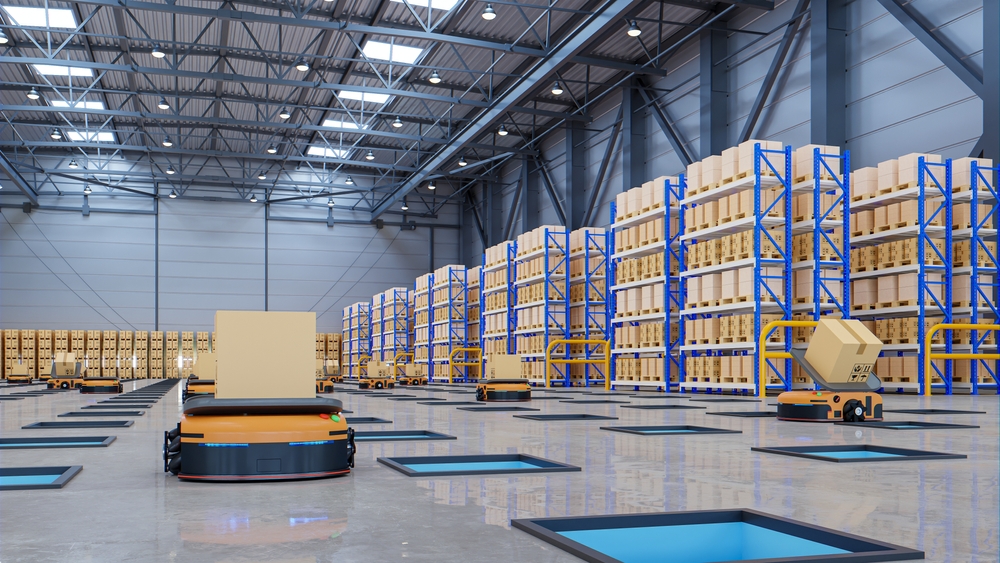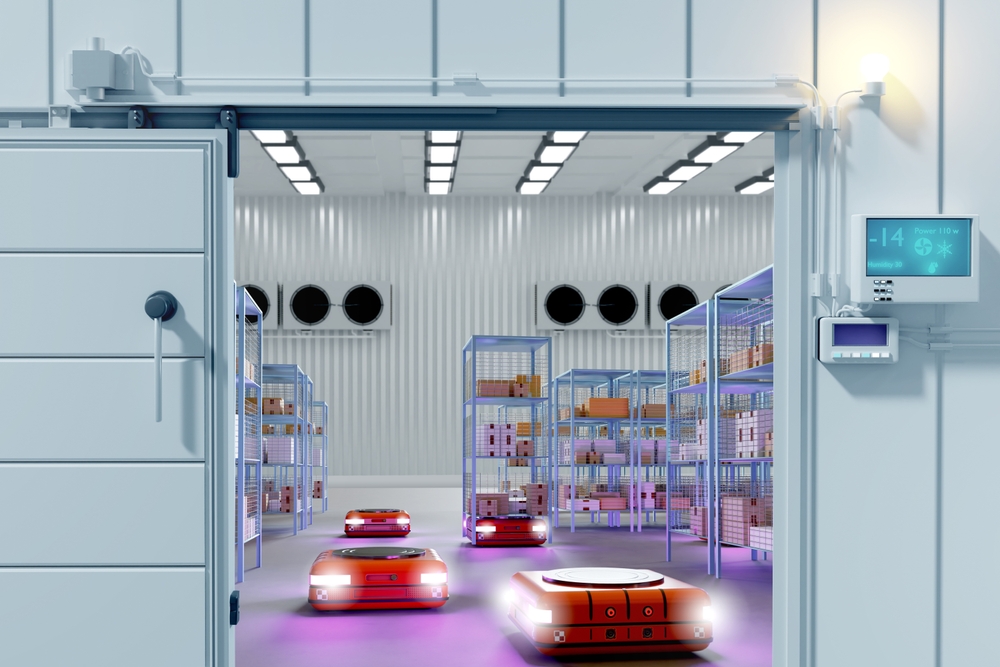The global market for AMR robots has grown exponentially, with an estimated CAGR of 17% between 2020 and 2030, rising from $2.7 billion in 2020 to $12.4 billion by 2030. This surge in need can be associated with the increasing demand for efficient and cost-effective solutions in various industries, particularly in warehousing and manufacturing.
In this article, we will explore the world of AMRs, their types, and the several benefits they offer to businesses. We will also introduce the AI Cobot Mobile Series from Techman Robot, which combines the power of cobots and AMRs to deliver cutting-edge automation solutions.
What Is an AMR Robot?
Businesses in the logistics industry, the agricultural sector, and the manufacturing sector are always on the lookout for methods to improve the speed, accuracy, and security of their operations in the workplace. Autonomous mobile robots (AMRs) are one such solution.
One form of robot that can function without human guidance is an autonomous mobile robot. AMR robots are distinct from their forerunners, autonomous guided vehicles (AGVs), which must follow tracks or other predetermined courses and often have human supervision.
AMRs can perceive and traverse their surroundings without being attached to a power source, thanks to a sophisticated combination of sensors, machine learning, artificial intelligence, and computing for route planning. Because AMR robots are fitted with sensors and cameras, they will resort to a navigation technique like collision avoidance if they encounter a sudden obstacle while navigating around them and then keep going with their task.
Types of Industrial Mobile Robots
All industrial or AMR robots can be largely divided into three categories:
AMRs for Moving Inventory Within a Facility
Autonomous mobile robots that move inventory within a facility can transport goods, raw materials, or finished products from one location to another. These AMR robots are equipped with LiDAR, cameras, and ultrasonic sensors, enabling them to navigate autonomously within the facility. They follow pre-defined paths or utilize real-time mapping to determine the most efficient route to their destination. Considering that, some examples of these types of AMRs include self-driving forklifts and specified warehouse/inventory robots.
AMRs for Assisting in the Picking Process
AMRs that assist in picking are able to streamline the order fulfillment process in warehouses as well as distribution centers. These robots work alongside human operators and reduce the physical strain of repetitive tasks, such as picking items from shelves or bins. Not only that, but these AMR robots utilize advanced technologies like machine vision, AI algorithms, and collaborative robotic arms to accurately identify and pick the correct items.
V2A044 TM AI Cobot – Automation collecting goods with AMR ft.LISTA
AMRs for Flexible Sortation Solutions
Flexible sortation solutions involve AMRs that can quickly adapt to different sorting tasks in distribution centers and warehouses. These AMRs can sort items based on size, weight, destination, or priority. They use advanced algorithms and real-time data to optimize the sortation process and ensure items are accurately sorted and routed to their correct destinations. Automated last-mile delivery robots, like drones, may fall under this category.
Why Incorporating AMR Robotics into Your Businesses?
Let’s now explore the numerous benefits of incorporating AMR robotics into your businesses:
Boosts Operational Efficiency
Incorporating AMR robots into your business processes can boost operational efficiency while streamlining workflows and reducing manual intervention. For example, AMRs can optimize warehouse routing and decrease the time required for material handling and transportation. Essentially, it leads to reduced energy consumption and a lower carbon footprint. Apart from that, since AMRs can work around the clock without fatigue, they contribute to higher productivity levels, further enhancing operational efficiency.
While using AMRs in production lines, businesses can also expect to see improvements in product quality and reduced waste. For instance, AMRs can perform precise assembly tasks, ensuring consistent quality and reducing the likelihood of human error. These robotic systems can also monitor production in real-time. It helps identify bottlenecks and inefficiencies and allows management to make informed decisions and address issues proactively.
V2A040 TM AI Cobot – CNC Machine Tending Application ft.Valk Welding
Increases Inventory Visibility
AMR technology can improve inventory visibility while automating inventory tracking and data collection tasks. Equipped with sophisticated sensors, cameras, and barcode scanners, AMRs can rapidly and accurately perform inventory audits and thus provide real-time updates on stock levels and locations. The increased visibility enables businesses to maintain optimal inventory levels, minimizing stockouts, overstocks, and associated carrying costs.
Besides improving inventory management, enhanced visibility allows businesses to gain valuable insights into supply chain dynamics. While analyzing data collected by AMR robots, businesses can identify patterns and trends, like seasonal fluctuations and high-demand items. These insights can be used to optimize procurement strategies, inventory turnover rates, and warehouse organization. It contributes to a more efficient and cost-effective supply chain.
Takes over Heavy-Duty Tasks
AMRs can equally handle heavy-duty tasks, such as moving large or heavy items, which can be physically demanding and time-consuming for human workers. While automating these tasks, AMR robots improve workplace safety by reducing the risk of injuries and freeing staff to focus on more valuable tasks requiring critical thinking and problem-solving skills. For example, AMRs can take over pallet transportation in a warehouse setting. It allows staff to concentrate on quality control, order processing, and customer service.
Integrating AMRs in the workplace also fosters an environment that encourages upskilling and workforce development. As employees transition from manual tasks to more strategic roles, businesses can invest in training and development programs. It ensures that their workforce remains competitive and adaptable in the face of technological advancements.
Streamlines Order Fulfillment
Incorporating AMR robots into the order fulfillment process can greatly streamline operations, leading to faster and more accurate order processing. AMRs can optimize picking routes and minimize travel distances while reducing the time it takes to fulfill orders.
Furthermore, AMRs can be integrated with Warehouse Management Systems and Enterprise Resource Planning software. It allows for seamless coordination between different stages of the order fulfillment process. Eventually, this integration also reduces order lead times, improves order accuracy, and increases throughput, enhancing customer experience.
Improves Customer Satisfaction
AMR technology can improve customer satisfaction through mobile delivery solutions. While employing AMRs for last-mile delivery, businesses can offer customers quicker and more flexible delivery options. E.g., AMR robots can be programmed to deliver packages during off-peak hours or navigate complex urban environments to reach customers in hard-to-reach locations. Plus, AMRs can have real-time tracking capabilities for customers to monitor the delivery status of their orders and receive updates on estimated arrival times.
Another advantage of using AMR technology for last-mile delivery is the potential for reduced delivery costs. Because AMRs can operate continuously and efficiently, they can lower labor and fuel expenses associated with traditional delivery methods. Undoubtedly, these cost savings can be passed on to customers through more competitive shipping rates or faster delivery options, which further enhance customer satisfaction.
AMR Solutions with Robot Arms
Collaborative robots (cobots) and autonomous mobile robots (AMRs) have been at the forefront of recent productivity and efficiency gains in the manufacturing and logistics sectors. Techman Robot, a pioneer in the robotics industry, takes this further with its AI Cobot Mobile Series, which offers an innovative solution by combining cobot arms and AMR robots for multi-function capability, flexibility, and high mobility.
Techman Robot’s AI cobots possess advanced AI and machine learning capabilities that enable them to continuously learn and improve their efficiency over time. A key feature of these cobots is their built-in smart vision system, which provides ease of use and versatility. It is ideal for various applications like material handling, AOI inspection, and palletizing.
If you want to learn more about the AI Cobot Mobile Series and find the perfect solution for your needs, please visit Techman Robot’s AI Cobot Mobile Series webpage.


